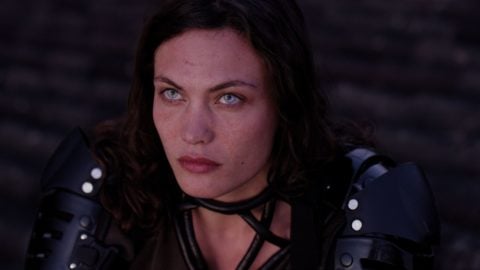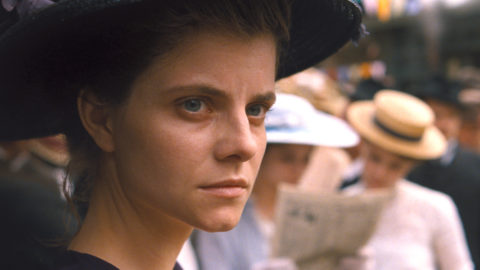Film of the Week: Los Reyes
Los Reyes screens Saturday, February 9 at Film Society of Lincoln Center as part of Film Comment Selects
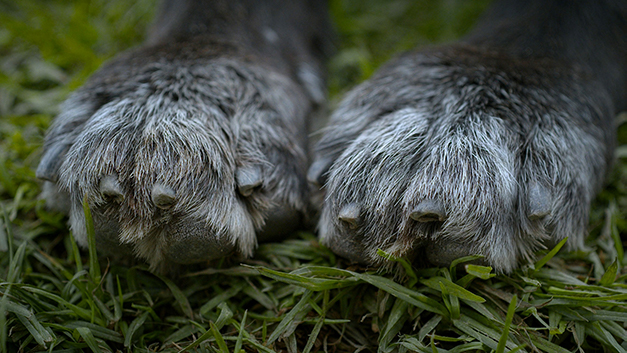
There’s a famous shot in Rossellini’s Rome Open City that is sometimes taken as a benchmark of the irreducibly real in cinema. Trucks are passing under a bridge, seen from above, when suddenly a dog rushes into the road from outside the frame—then turns and rushes back the way it came. This image is sometimes held up as emblematic of the way that neorealist cinema laid itself open to contingency. Rossellini could have abandoned this shot, deeming it spoiled by a happenstance incident that distracts us from the main action. Instead the dog’s sudden dash is retained as a token of the way that things—natural, uncontrollable things—just happen in the real world.
It is possible to control animals in film, to train them to do or not do certain things, but it’s sometimes far more interesting to let them dictate matters. That’s what appears to have happened in Los Reyes, an extraordinary film by the Chilean duo Bettina Perut and Iván Osnovikoff, screening on February 9 in Film Comment Selects.
The duo originally set out to make a documentary about the young human inhabitants of Los Reyes, a skate park in Santiago, but found themselves increasingly fascinated by two dogs that lived there. Perut and Osnovikoff continued, to a degree, to focus on their original subjects, recording the skateboarders’ daily conversations, but the film ended up becoming a study of the two dogs, or rather, of a small patch of world of which the dogs have become the stable center.
Los Reyes is a film in which, to all intents and purposes, nothing happens. It contains no events in the conventional sense. Time simply passes, the skateboarders talk, and the dogs are ever-present, just doing what dogs do, often repetitively and monotonously, but it becomes apparent that repetition and monotony are integral parts of animal experience, as much as of our own.
We only learn the dogs’ names in captions at the end: they are Fútbol, a large, shaggy, seemingly aged mutt, grey around the chops, often panting heavily as if exhausted; and Chola, a sleek if dirt-encrusted black Labrador. It would take a seasoned dog watcher to detect specific signs of personality in the duo; in fact, they often seem to exchange roles, one lounging around languidly while the other runs around excitedly, then vice versa.
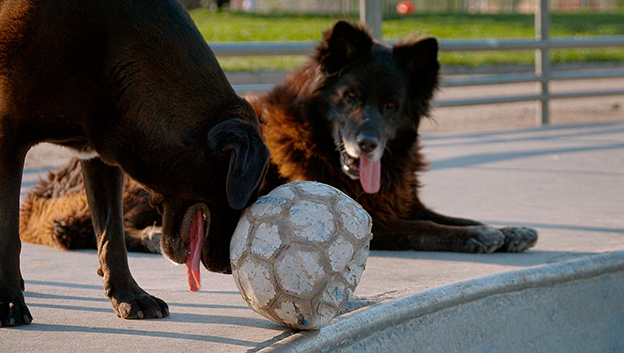
The dogs are never filmed in such a way as to make them look endearing or “characterful.” The only moment that seems to highlight obviously photogenic “dogginess” is when one or the other is shot from below, peering over the rim of a skate ramp, snout and paws hanging over the edge. Otherwise, the film comes across as a detached study of dogs just doing things, things that often seem pointless—just a matter of killing time or staving off boredom. There’s very little in the film about survival or the promptings of instinct: we barely see the dogs eating, and we don’t see them defecate. There’s a certain discretion involved; the camera only watches from above, at a distance, when Fútbol mounts another dog that has ventured along. Chola looks on, a few steps away—who knows whether with interest or indifference. The film doesn’t ever encourage us to attribute quasi-human responses to the dogs, even though we’re likely to, through sheer force of habit. But this sequence itself contains a wonderful example of the Rossellini effect mentioned above, as we’re distracted from the dogs’ mating by our sudden awareness of a skateboard sliding into view at the top right of the frame, and rolling down onto the track below: a wonderful accident (one can only assume) that makes the shot stranger than it might otherwise have been.
The film’s human subjects, largely male but some female, remain a strong presence. Their faces remain out of shot, but we sometimes see their hands in close-up, rolling joints, or their sneakered feet, while their off-screen voices recount daily worries: family arguments, pregnancy, run-ins with police or addicts or other denizens of Santiago’s street life. It’s not always clear what their social background is, middle- or working-class, but they worry that things are getting tough in Santiago, or entertain wild dreams, like one boy’s ambition to open a shop selling cannabis edibles.
As far as survival goes, the kids have perfect role models in the dogs, who don’t have much going for them, but endure. There are ramshackle kennels on site, with blankets, but the dogs sometimes seem content to sleep in the rain. What they mainly devote themselves to is distraction, sometimes distractedly, sometimes with obsessive commitment. Chola has a thing about tennis balls: it involves shoving one around with the tip of her nose, until it falls onto the skate track, at which point she sometimes watches it intently, as if to see what it’ll do next. Fútbol sometimes stands watching this activity with rapt fascination, trembling with alertness. Fútbol’s own thing, meanwhile, is to grab objects in his jaw and hang on for dear life. Crumpled footballs, soda bottles, sticks, even a substantial rock that takes some considerable grappling—all these are subject to an irrepressible will to chomp, which is Fútbol’s way of imposing himself on the world. It’s this that makes these dogs the “kings” (reyes) of the title and of the park—tennis balls their orbs, bottles their scepters.
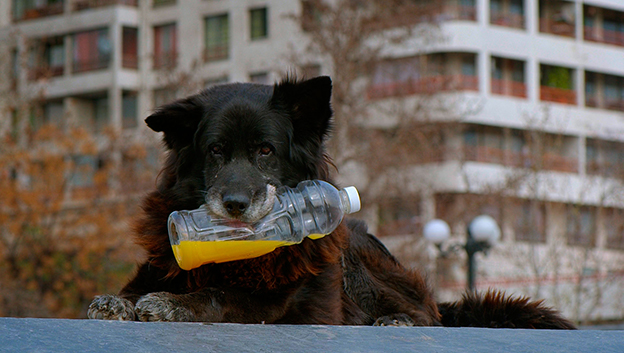
It seems an outrageous, even perverse challenge: 75 minutes in a skate park, watching two dogs do nothing exceptional. But like the best films about the everyday, Los Reyes makes us reassess our ideas of what is and isn’t interesting in the world. The directors’ own editing sometimes shapes little fragments of narrative out of mundane incidents or patterns of habit, some of which presumably recurred pretty much every day over the two-year shooting period. Sometimes, little repetitions and variations have a comic effect: one dog takes off, barking furiously, after two trotting mules as they clatter along a path; a little later, it happens again, with the mules clattering back the other way.
Pablo Valdés’s intensely sharp photography is full of striking compositions that make the ordinary beautiful, without falsely aestheticizing it: a park bench is dwarfed by skyscrapers in the background, a puddle shot at ground level resembles a vast lake. But what’s especially impressive is the way that the film explores the polarities of scale: city panoramas on one hand, minute details on the other. The camera maps the animals’ bodies in extreme close-up: studies of noses or dry paw pads capture textures like distressed tires; Fútbol’s shaggy fur reveals a forest of individual hairs, black, tan, blue-grey. We also see the flies that accompany the dogs, sometimes individually, sometimes in swarms—and we see them at disconcertingly close range. One shot shows a fly in massive close-up—then waits, after it’s flown off, to show a droplet of dog’s blood ballooning in the place where it has sucked.
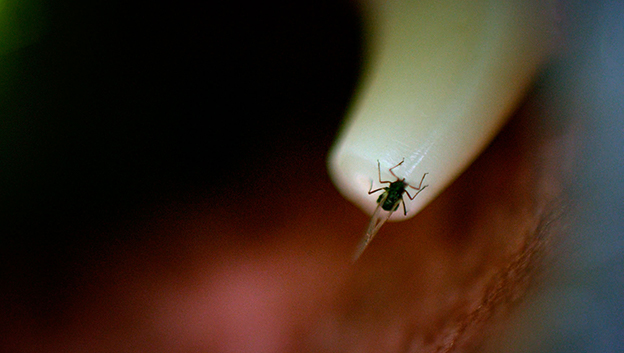
Some close-ups create visual rhymes. The screen is filled with a bright yellow flower that, among other things, signals the arrival of spring. But you also notice that it’s almost the exact same yellow as the tennis balls seen in close-up throughout—sometimes fresh, sometimes filthy with mud and saliva—and as the hi-vis jackets of the park workers. It’s hard to say whether this is something that the film specifically directs us to notice; perhaps we’re just picking up on certain patterns that organize the shape of the world as the dogs experience it. By contrast, there’s also a shot of a skater’s move, with the camera mounted on the board: it feels like a false touch, because it’s incongruously dynamic and spectacular, but also because it’s so far out of the dogs’ orbit, a disruptive flurry of human business.
Along with the photography’s accentuated dynamics of scale, there are sound dynamics to match, from the closely recorded voices of the kids, filling the film’s soundspace, to the distant buzz of the city in the background. Sound designer Janis Grossmann—who also worked on the hypnotic Spanish documentary The Hidden City, also in Film Comment Selects—has created a vividly textured collage, and clearly taken some liberties in the process. A particular sound made by the dogs—like Fútbol’s gruff, old-mannish bark, or Chola’s desolate extended howl—may have been made at another moment altogether, and perhaps the dogs weren’t actually whining when they’re heard to be. But poetic license, as in the editing, is a constituent part of this mesmerizing evocation.
The film lets us decide whether there’s an equivalence, or a contrast, at work between the park’s humans and the dogs; apart from one boy talking at length about his grandmother calling him a dog, the point is never emphasized. Films about animals invariably prompt us to see beasts as versions of ourselves, whether it’s the elevated likes of Au Hasard Balthazar or cheerful anthropomorphism such as Disney’s The Incredible Journey: the best also discourage that solipsistic tendency. Apart from the title, there’s little anthropomorphic about Los Reyes, and while it sometimes scales life down to the canine level, making this one park as big as the world, it doesn’t, I think, presume to show us the world as the dogs see it. It is simply a film about life lived up close, about the objects and the creatures at hand, the immediate moment: it shows its subjects behaving at times with absolute casualness, at others as if every tiny thing was as important as life itself.
Closing titles tell us that while Chola still lives in the park, Fútbol—to whom the film is dedicated—died in December 2017. Fútbol, the caption says, was a “unique and exemplary” dog. In fact, what the film tells us so wonderfully is that he was just a dog, seemingly no more unique than any other—but also that any animal, looked at attentively and patiently enough, becomes not just exemplary, but the living, hearing, seeing center of the world.
Jonathan Romney is a contributing editor to Film Comment and writes its Film of the Week column. He is a member of the London Film Critics Circle.



